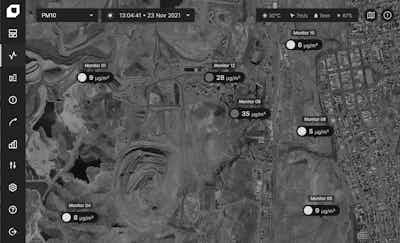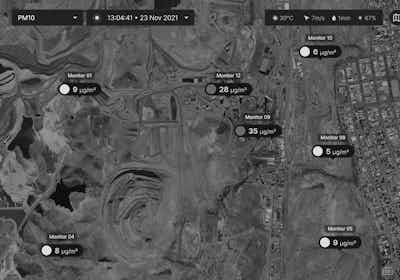If the weather conditions are right, most routine activities at mining operations can lead to dust events. Fugitive dust emissions produce a serious health risk for workers across the site but also for surrounding communities in the vicinity of the operation.
Particulate matter (PM) emissions can be highly variable over time due to changes in weather conditions. To further complicate mitigation efforts, some of the most problematic levels of dust particles are often invisible.
Some methods for dust control at mining sites, such as spraying high-risk areas with water, are only effective to a certain extent or in the right context. Water is a costly resource on remote sites and must be used effectively.
Actively monitoring and mitigating risks to keep safety at the forefront while ensuring maximum production is a delicate balance. Modern software has made it far more achievable for non-experts today.
First things first: Proactive dust management requires situational awareness
Most mining operators can relate how difficult it is to find the balance between meeting production targets and making sure their site is prepared for weather risks that lead to compliance breaches. Situational awareness is necessary when managing environmental variables and can be the difference between continuing production or halting operations.
To understand a complete picture of what is happening on an open pit mine site at any given time, operators need access to highly accurate and real-time information about changing environmental conditions. Predictive and real-time insights are essential for effective dust management strategies, which enable mine operators to make informed decision and minimise dust impact while focussing mitigation resources on exactly the right area in the mine.
Examples of proactive dust management strategies driven by software at open-pit mines
While it is helpful to identify and resolve a dust problem as it is occurring, a more ideal strategy revolves around mining operators to try avoiding excessive dust incidents happening in the first place. This requires access to sophisticated information that can be interpreted by non-subject matter experts quickly and effectively.
Today’s advanced dust management software options have made this possible.
It is now possible for non-subject matter experts to gain far more context from dust monitoring data than previously possible to respond confidently to changing conditions. This results in effective dust management strategies, making them less burdensome and more realistic for modern-day operators.
Strategy 1: Acting on insights from real-time dust monitoring networks to support TARP
Problematic levels of dust particles can be invisible at mine sites. PM emissions are often highly variable over time and their impacts strongly depend on weather conditions. In all cases, knowing the scale of the problem needs measurement and analysis.
Operational dust management strategies or Trigger Action Response Plans (TARP) used at mining operations rely on continuous, unattended monitoring of emissions risks. However, it can be difficult to act on static data without context.
As a proactive approach, mine operators can access insights from combining data from real-time dust monitoring hardware with local weather conditions. This information provides actionable insights for operators to mitigate unfolding emissions by visualising where they should focus dust management efforts. This allows for complete situational awareness of a mining operation at any given time.

Strategy 2: Planning operations in advance with emissions modelling and hyperlocal weather forecasting
Another key strategy for dust management at a mining site involves the use of emissions modelling and hyperlocal weather forecasts to plan activities ahead of time. Advanced dust management software uses this to provide a 72-hour window into the future when it comes to operational planning.
Modern dust management software offers high-definition, site-specific weather conditions paired with dust parameters that enable mine operators to run multiple operational scenarios and avoid dust impact. Operational teams can use this to estimate the ideal timeframe to carry out specific operational activities that lead to high dust risk.
Strategy 3: Engaging with neighbouring communities transparently about operational improvements and dust control
Dust events caused by mining sites can put strain on relationships with surrounding communities. Most of the time this leads to an increase in complaints, negative publicity, and operational delays.
Rapid response is of the highest importance when community members direct dust complaints at mining operations. Dust management strategies can now incorporate transparent communication practices with surrounding communities.
Advanced algorithms in dust management software can be used to quickly identify and resolve nuisance complaints. The cause of dust events and how they are being rectified, can be communicated in an easy-to-understand way for all stakeholders.
EVS Omnis: Best-in-class dust management software for mining operations
EVS Omnis is a cloud-based environmental management software built for today’s mining industry. The software enables site operators to act on insights from continuous dust monitoring systems. It can also be configured to trigger alerts in case of threshold exceedances, enabling operators to take proactive measures for dust mitigation.
Productivity at mine site relies purely on continuous uninterrupted operations and minimal downtime. EVS Omnis equips operators with real-time dust monitoring and hyperlocal weather forecasts to plan for activities up to 72 hours in advance. Rather than navigating complex dust issues during an unexpected emissions event, operational teams can remain prepared ahead of time with hyperlocal weather forecasts and emissions modelling.
In addition, EVS Omnis advanced modelling features include reverse and forward trajectories that enable mining operators to identify the source of dust emission complaints or know when they may impact communities.
Envirosuite’s EVS Omnis is trusted on a global scale and currently supports some of the world’s most environmentally constrained mines. Find out more on how EVS Omnis can revamp existing dust management strategies at your mining site.
